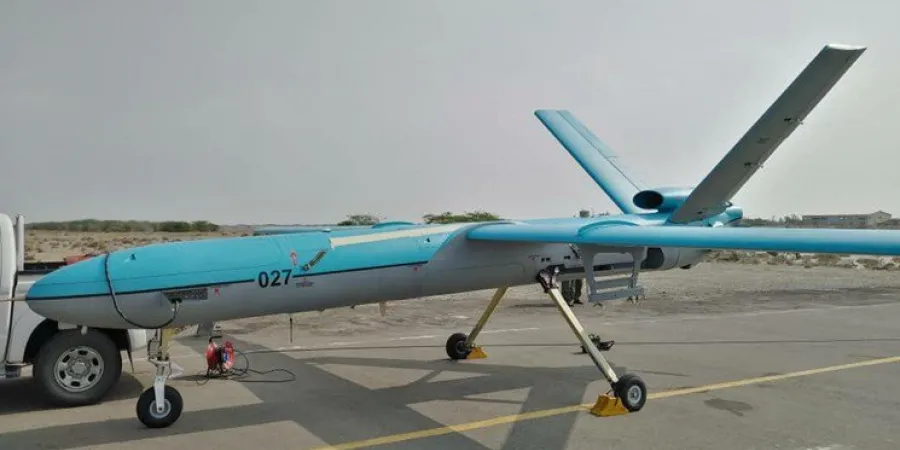Iran Initiates Build-Up of Naval-Aerial Unmanned Force
The acquisition of UAVs for the naval theater reflects a change of concept in Iran, which regards its navy as a strategic arm capable of dealing with the American threat and operating in remote areas, possibly even the Mediterranean
Cmdr. (res.) Eyal Pinko
| 12/12/2019
Two new unmanned aerial vehicles in service with the naval forces of Iran have been introduced recently. The first UAV, designated Simorq, was unveiled in early December 2019 by the commander of the Iranian Navy, Hossein Khanzadi. The UAV, which closely resembles Elbit Systems’ Hermes 450, is the naval mission version of the Iranian Shahed-129 UAV.
The Shahed-129 has been operational for a number of years with the naval and aerial forces of the Islamic Revolutionary Guard Corps (IRGC). This vehicle has an endurance of up to 24 hours, a maximum range of 1,500 kilometers and a flight altitude of 24,000 feet. It was adapted for employment by the Iranian Navy in the role of maritime surveillance – detecting vessels far away from the Iranian shore.
The other UAV introduced recently is the Pelican-2 – an unmanned vehicle capable of Vertical Take-Off and Landing (VTOL) from naval vessels. The Pelican-2 has four motors and five propellers and can take off and land from the decks of the surface vessels of the Iranian Navy. It carries optical sensors enabling detection of vessels during the day and night. No information was provided regarding the performance characteristics of this UAV.
The acquisition of UAVs by the Iranian Navy indicates the concept the navy is currently consolidating with regard to naval warfare. The new concept includes not just surface vessels and submarines and engagements close to the shore, but also the extensive employment of UAVs, flying at considerable distances from the shore and from their parent vessels. These UAVs help assemble a maritime target picture and transmit their data, in real time, through a communication channel of the parent vessel and to the shore.
This capability is highly significant for the Iranian Navy, as it provides it, on the one hand, with command and control of the maritime target picture within extended ranges and in real time, while on the other hand enabling it to employ the modern weapon systems it has acquired recently, like the Ghadir and Qader anti-ship missiles to ranges of 300 and 500 kilometers.
The surveillance systems fitted to the UAVs enable the Iranian naval vessels to assemble a maritime status picture extending far beyond the horizon, thereby taking advantage of the maximum range of their anti-ship missiles. This capability, like other capabilities, indicates the change in the Iranian strategic concept, which currently regards the Iranian Navy as a strategic arm, assigned to operate at long distances from the shore, making it possible to deal with the US threat far away from the Iranian shore, as well as to operate in such remote areas as the Red Sea and, in the future, possibly the Mediterranean as well.
The acquisition of UAVs for the naval theater reflects a change of concept in Iran, which regards its navy as a strategic arm capable of dealing with the American threat and operating in remote areas, possibly even the Mediterranean
Two new unmanned aerial vehicles in service with the naval forces of Iran have been introduced recently. The first UAV, designated Simorq, was unveiled in early December 2019 by the commander of the Iranian Navy, Hossein Khanzadi. The UAV, which closely resembles Elbit Systems’ Hermes 450, is the naval mission version of the Iranian Shahed-129 UAV.
The Shahed-129 has been operational for a number of years with the naval and aerial forces of the Islamic Revolutionary Guard Corps (IRGC). This vehicle has an endurance of up to 24 hours, a maximum range of 1,500 kilometers and a flight altitude of 24,000 feet. It was adapted for employment by the Iranian Navy in the role of maritime surveillance – detecting vessels far away from the Iranian shore.
The other UAV introduced recently is the Pelican-2 – an unmanned vehicle capable of Vertical Take-Off and Landing (VTOL) from naval vessels. The Pelican-2 has four motors and five propellers and can take off and land from the decks of the surface vessels of the Iranian Navy. It carries optical sensors enabling detection of vessels during the day and night. No information was provided regarding the performance characteristics of this UAV.
The acquisition of UAVs by the Iranian Navy indicates the concept the navy is currently consolidating with regard to naval warfare. The new concept includes not just surface vessels and submarines and engagements close to the shore, but also the extensive employment of UAVs, flying at considerable distances from the shore and from their parent vessels. These UAVs help assemble a maritime target picture and transmit their data, in real time, through a communication channel of the parent vessel and to the shore.
This capability is highly significant for the Iranian Navy, as it provides it, on the one hand, with command and control of the maritime target picture within extended ranges and in real time, while on the other hand enabling it to employ the modern weapon systems it has acquired recently, like the Ghadir and Qader anti-ship missiles to ranges of 300 and 500 kilometers.
The surveillance systems fitted to the UAVs enable the Iranian naval vessels to assemble a maritime status picture extending far beyond the horizon, thereby taking advantage of the maximum range of their anti-ship missiles. This capability, like other capabilities, indicates the change in the Iranian strategic concept, which currently regards the Iranian Navy as a strategic arm, assigned to operate at long distances from the shore, making it possible to deal with the US threat far away from the Iranian shore, as well as to operate in such remote areas as the Red Sea and, in the future, possibly the Mediterranean as well.



